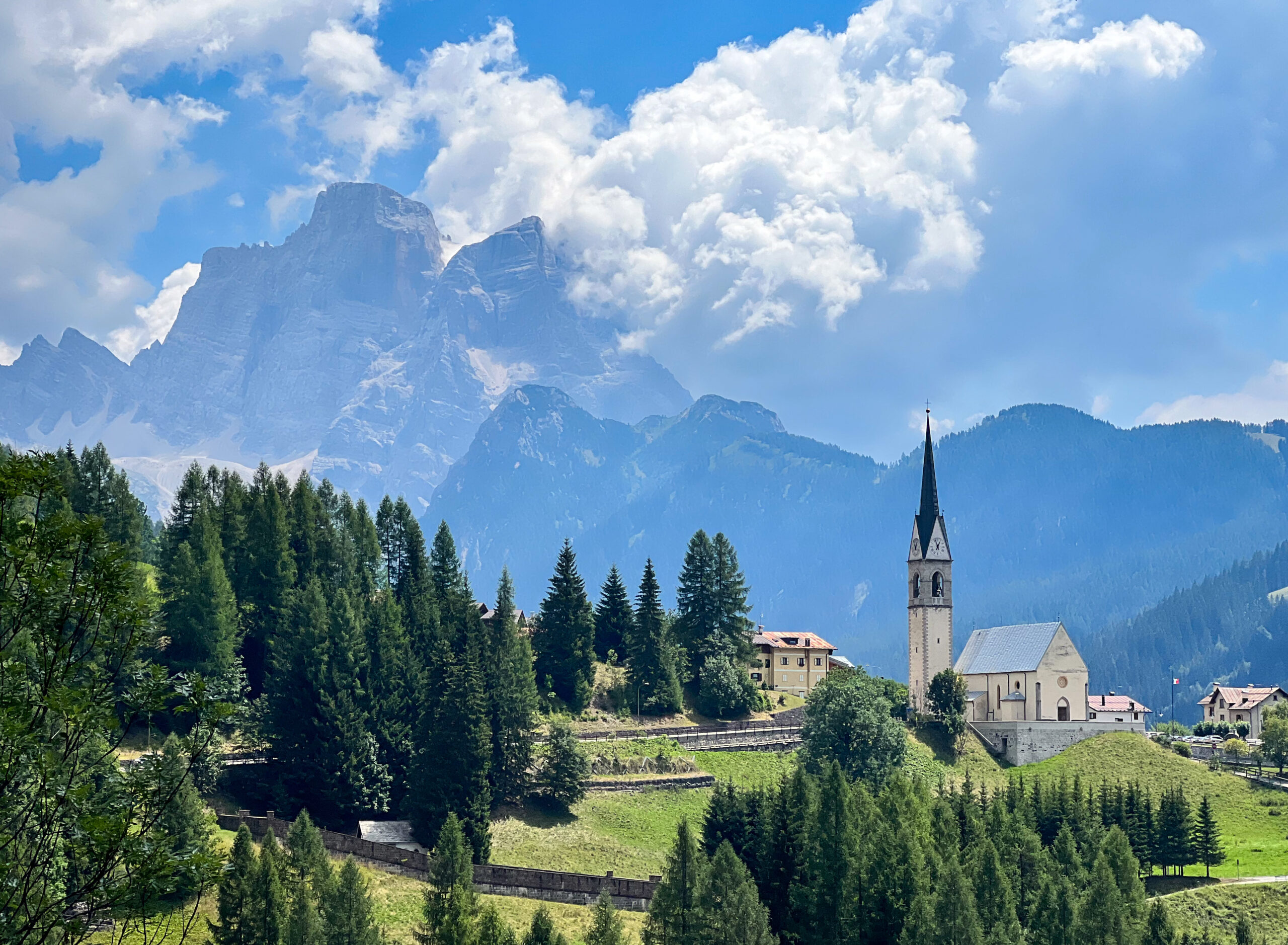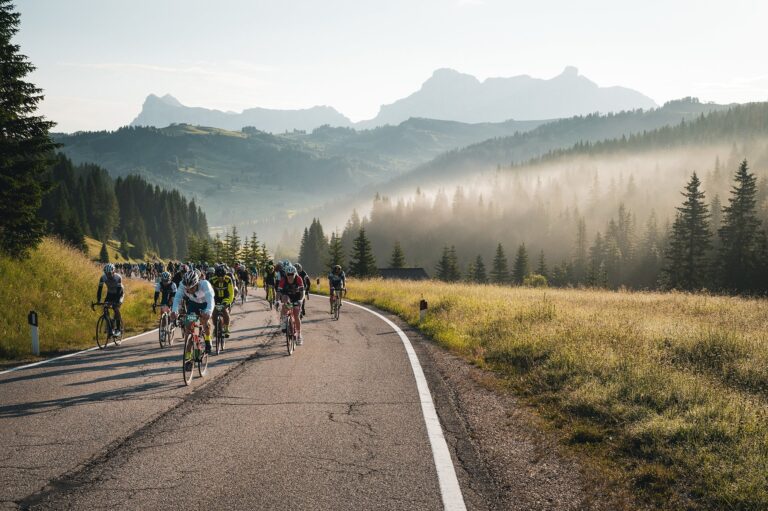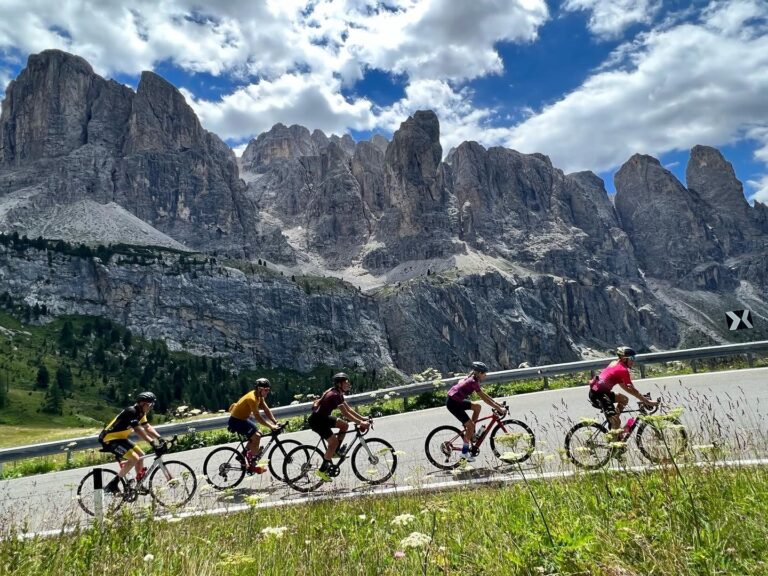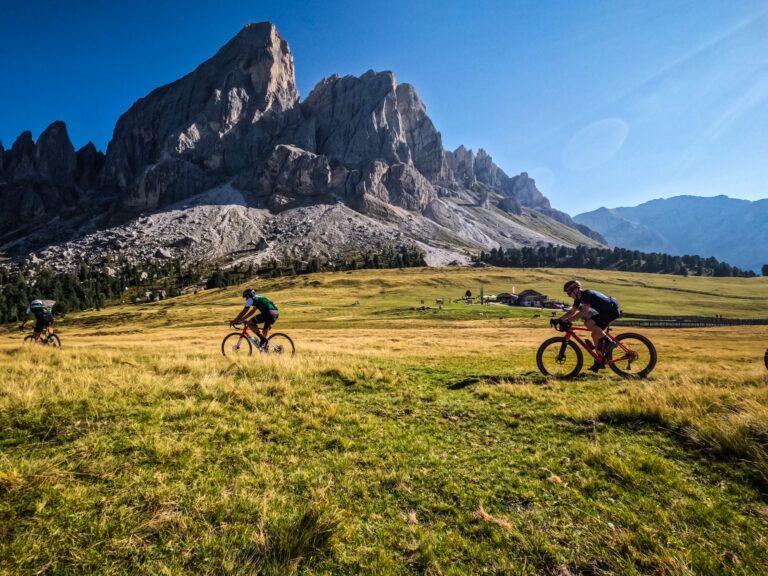Passo Giau: The Most Feared Climb in Italy’s Dolomites
In a mountain range known for its iconic climbs, there’s none that is more revered—or feared—than Passo Giau. Nestled in the heart of the Italian Dolomites, Passo di Giau (you’ll see it referred by both names) stands as a testament to both the brutal challenges of cycling and the rugged natural beauty of Italy’s Dolomite mountain range. And because of its inclusion in the famed Giro d’Italia, Passo Giau has cemented a reputation among cyclists and fans alike for its precipitous gradients, otherworldly scenery, and rich cycling lore.
The climb of the Giau, as it is affectionately known, epitomizes all that the Dolomites has to offer: It boasts scenic grandeur, it’s steeped in cultural and historical significance, and it serves as a proving ground for your ability to persevere.
This is why, whenever you come to northern Italy, you must test yourself on one of Italy’s most historic and feared road cycling climbs. The Giau Pass is one of my personal favorite Italian road cycling climbs and can be part of your fully custom Secret Dolomiti Cycling Tour with Alter Exploration.
The Profile of Passo Giau
If you ride from the most classic approach, that of the Colle di Santa Lucia, Passo Giau travels 9.9 km through 29 hairpins (or tornanti) to reach an elevation of 2,305 meters (7,562 feet). Passo Giau is renowned for its average gradient of 9.3%; but what makes this climb particularly challenging are sections that steepen to 14%. This “hard” side of the climb starts in the quaint village of Selva di Cadore, winding its way through lush larch forests before launching above treeline into a jagged mountain landscape.
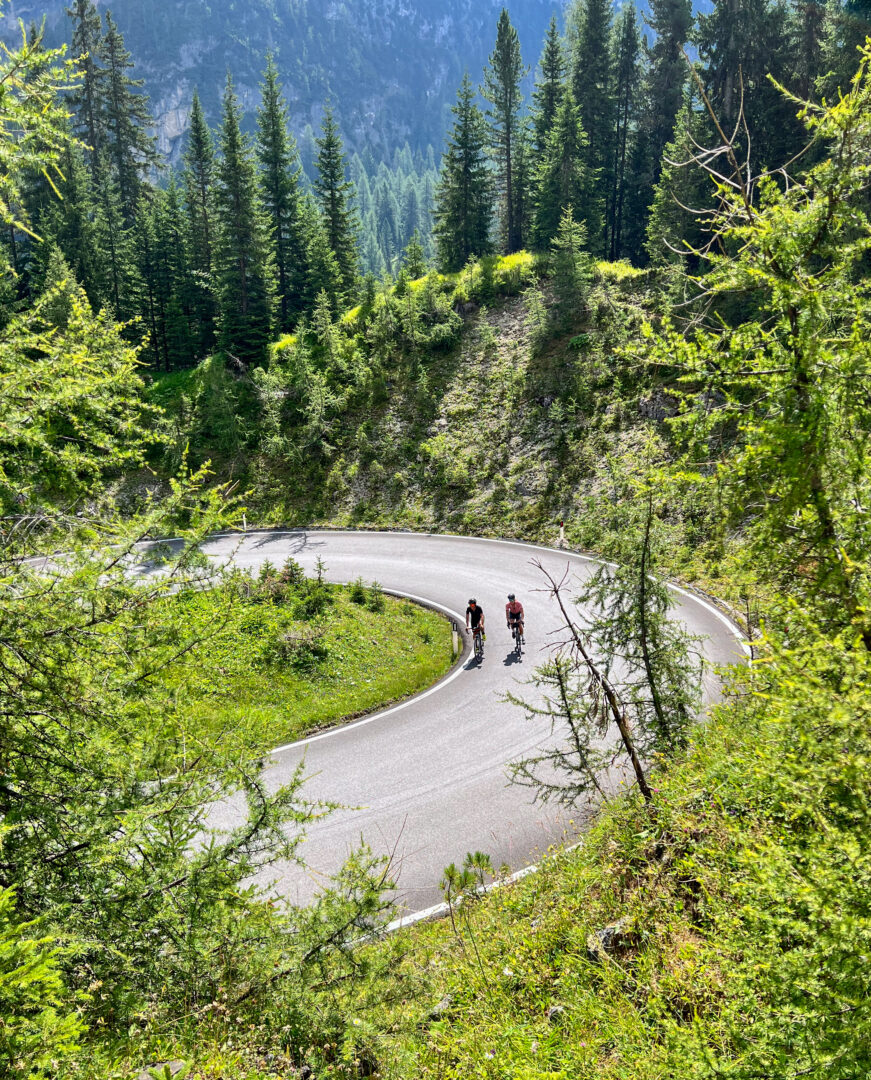
The enchanting scenery opens up near the top of the pass, revealing alpine meadows scattered with small wooden huts and the rocky cliffs of the Dolomites as a backdrop. The peak of the Nuvolau looms as an imposing beacon high above.

Passo Giau is the climb by which all climbing routes in the Dolomites are measured.
Cycling from Cortina d’Ampezzo to Passo di Giau
The “easy” side begins close to the ritzy alpine ski town of Cortina d’Ampezzo which will host events during the 2026 Winter Olympics.
The road itself, flanked by towering Dolomite rock formations, offers a surreal experience, often shrouded in mist or basked in sunlight. This dichotomy—of beauty and challenge—captures the essence of cycling Passo Giau.

The History of Giau Pass and the Giro d’Italia
Passo di Giau has a place in cycling lore built upon its frequent inclusion in the Giro d’Italia, one of three prestigious grand tour cycling races in the world alongside the Tour de France and Spain’s La Vuelta. Italy’s legendary race, founded in 1909, has showcased some of the most exhilarating climbing battles in cycling history, with Passo Giau at the center of the drama on several occasions.
The first significant appearance of Passo Giau in the Giro d’Italia was in 1973, with the last kilometers of the climb, unpaved at the time, making it even harder.
The true legend of this Dolomite climb, however, has been established mainly in the last 15 years of the Giro. Passo Giau was included in Giro stages six out of nine times between 2007 and 2016.
One of the most epic pages of recent Giro history was written by Egan Bernal on stage 16 of the 2021 edition of the race. The Colombian cyclist, already clad in the overall leader’s pink jersey, was prepared for a decisive Dolomite test in the Sacile-Cortina d’Ampezzo stage, which was supposed to be 212 kilometers and instead became 153.
The weather that day was brutal: rain, frost, and impassable roads forced the organizers to cancel the climb over the Passo Fedaia and the Passo Pordoi; the crux of all 21 stages of the Giro d’Italia came down to the Passo Giau and the highly anticipated descent from the pass into Cortina d’Ampezzo.
On the climb, bad weather garbled the television signal, heightening the drama, but the few images that came through were clear: Bernal went on the attack. He dropped all of his rivals, flying all the way to the summit of the Giau before setting off downhill. In Cortina, despite the rain and the cold, Bernal shed his rain jacket and crossed the finish line with the radiant Maglia Rosa in full view.
While the climb’s reputation as a test of endurance, strength, and tactical skill has been cemented over decades, it has always been a beloved challenge for road cyclists. Passo Giau is the climb to which all climbing routes in the Dolomites are compared.

Passo Giau is a rite of passage for discerning cyclists seeking the world’s premier cycling challenges.
The Allure of Cycling the Dolomites
Beyond the challenge of Passo Giau, the Dolomites offer countless cycling routes, paved and unpaved, making the Dolomites a true cycling paradise. The region’s dramatic landscape features jagged peaks, lush meadows, quaint steeple-riddled villages, and snaking ribbons of pavement and secret gravel paths and tracks. For more, consider the Four Passes of the Sellaronda, Maratona dles Dolomiti, or the off-road YOLOMites5000.
While I prefer to stay in the small village of Badia, it’s nearly inevitable (and worth it) to visit Cortina d’Ampezzo, a picturesque town known for its stunning alpine scenery and vibrant culture. I like to think of Cortina as the Aspen of Italy: swanky, good for people watching and mountain staring, filled with fancy restaurants and high-end gear shops.
But there’s nothing like cycling the climbs of the Dolomites. And Passo Giau is among the greatest. In fact, it is more than just a legendary climb; Passo Giau is a rite of passage for discerning cyclists seeking the world’s premier cycling challenges. Ride Passo Giau and you will understand why cyclists from every corner of the globe are drawn to Italy’s magnificent Dolomites.
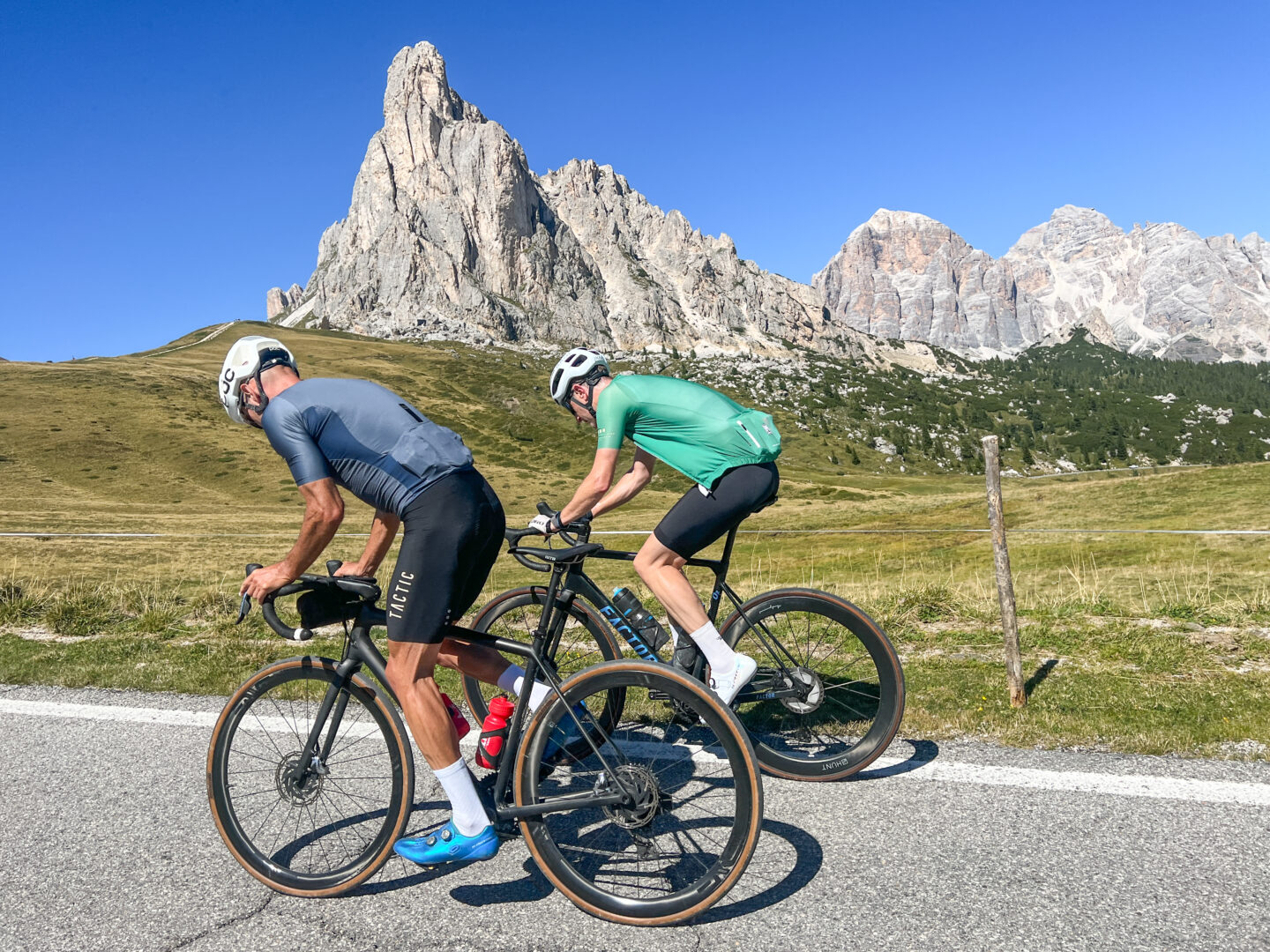
Passo Giau is the climb to which all climbing routes in the Dolomites are compared.
5 Tips for Cycling Passo Giau
1. Choose the right season: The best time to tackle Giau Pass is during the warmer months, from late spring to early fall. Early mornings or late afternoons can offer cooler temperatures and fewer crowds. My favorite times are early June and late September, and the groups I’ve guided on Secret Dolomiti cycling tours love the weather for riding in this time range.
2. Hydration and nutrition: Bring plenty of water and snacks, though you should know that one of the best rifugios, or mountain huts, in the Dolomites sits at the summit of the climb—the Berghotel Passo Giau. Here you can grab something to eat—from pastries to sandwiches to soups—and drink. Try the cioccolata, the ultra-rich Italian version of hot chocolate.
3. Gear selection: Be sure your bike is equipped with a wide range of gears for steep climbs; a compact crankset can help you tackle the gradient more efficiently, and paired with a wide-range cassette (like a 11-34 or if you’re running a 1x setup, an 11-45). If you’re planning to ride a gravel bike to take advantage of the Dolomites incredible gravel cycling, typical gravel bike gearing will work very well on Passo di Giau.
4. Pacing: Start at a comfortable pace and avoid going too hard at the beginning. The climb is challenging, and conserving energy for the steeper sections is key. Try “chunking” the climb into smaller sections by only focusing on a small portion at a time—perhaps that’s the next kilometer or to the next big tree or landmark. Tick off the boxes one at a time.
5. Enjoy the journey: I understand the temptation to ride hard, to test yourself and see how you stack up against the times of the best cyclists in the world, but consider taking breaks to appreciate the views and the experience. The sheer grandeur of the Dolomites is as much a part of the journey as the effort of the climb.
Ride It with Alter Exploration
Challenge yourself on Passo Giau! Join Alter Exploration for our next Secret Dolomiti Cycling Tours in June and July. See more about the destination and our fully custom itineraries.



